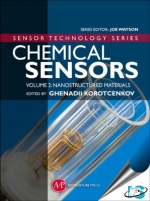Tab Article
Nanomaterials and nanotechnology are new fields of science and technology. Nanotechnology is still in its infancy, because nanotechnology has become a hot area globally since a few years ago. However, it is expected that nanotechnology will dramatically change operating characteristics of chemical sensors and will probably gain in importance in all fields of sensor application over the next ten to twenty years. It was found that with reduction in size, novel electrical, mechanical, chemical, catalytic and optical properties can be introduced. Besides it was established that 1-D structures can be ideal system for studying the nature of chemical sensing effects.
Taking into account the importance of nanostructured materials impact in further development of chemical sensors, we have selected and collected information of those materials in separate volume: Nanostructured Materials. This book includes eight chapters written by researchers who are at the forefront of their field which address the role of nano materials in chemical sensors. In this volume one can find detail analysis of materials such as 1-D metal oxides nanostructures, carbon nanotubes, fullerences, metal nanoparticles and nanoclusters. The processing, properties and application of nanocomposites, porous semiconductors, ordered mesoporous materials and zeolites are also discussed in the volume. Brief history of nanotechnology, peculiarities of nanomaterials properties, specificity and future trends of nanotechnology can be find in this volume as well.
We believe that acquaintance with results presented in our book will provide scientists with new insights for understanding and improving existing devices and clues for ways to design new nanostructured materials for making better chemical sensors. We are sure that our book will be useful to the readers, students, scientists and engineers, which have interest to both chemical sensors and nanomaterials.


